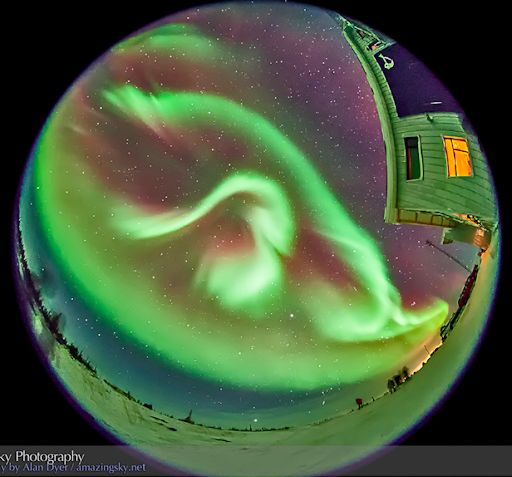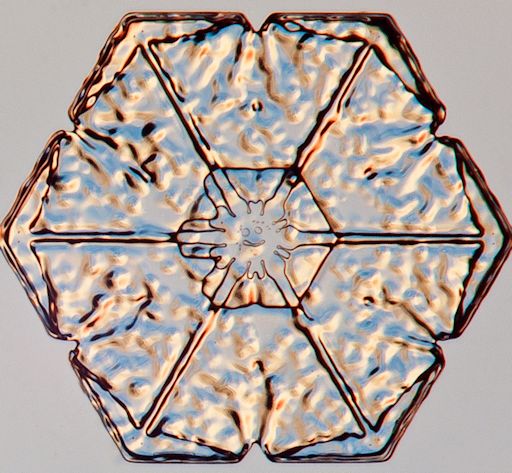WEEKEND STORM WARNING: Polar geomagnetic storms are possible on Saturdy, Feb. 8th, when a solar wind stream and a minor CME are expected to hit Earth's magnetic field. This will not be a major storm, but the double-impact could spark high-latitude auroras. Aurora alerts: text, voice
UNDER THE AURORAL OVAL: There is a place on Earth where you can see auroras almost every clear night even when there is no geomagnetic storm. It is under the auroral oval. The auroral oval is a donut of light around the poles which never goes completely dark because it is excited by energetic particles raining down from Earth's magnetosphere. Feb. 3rd was a very good night to be under the oval:
"What an amazing night this was!" says Alan Dyer of Churchill, Manitoba, Canada. "On the night of Feb 3-4, despite all indicators showing quiet levels of activity, the sky exploded with a stunning all-sky display of rippling curtains across the sky. Churchill is under the prime auroral oval, so we see Northern Lights almost every clear night, even when official indicators are reading low or no geomagnetic storms."
"These images are from the Churchill Northern Studies Centre, a non-profit research institute for Arctic science and that also offers aurora-watching and other Arctic tours through the year, including polar bear viewing in the autumn," he continues. "No words can describe the view of rapidly waving curtains of light rippling from horizon to horizon. All the tour group members left satisfied they had seen the celestial experience of a lifetime."
According to NOAA forecasters there is only a 5% chance of geomagnetic storms on Feb. 6th. That's more than enough, however, under the oval. Aurora alerts: text, voice
NOT EVERYTHING IS SPACE WEATHER: Snowflake photographer Ivo Dinsbergs of Riga, Latvia has something to report. "Its not exactly space weather, but still interesting," he says. "The temperature on Feb. 5th was only -3°C, too warm for good snowflakes, but I went outside anyway." When he looked through his lens, this warm snowflake gave him a rueful smile:
"Since 2010, I have taken hundreds of snowflake photos, but this is one of the most unique," says Dinsbergs. "All other my snowflakes can be found here."

Solar wind
speed: 381.1 km/sec
density: 0.3 protons/cm3
explanation | more data
Updated: Today at 1647 UT
X-ray Solar Flares
6-hr max: C4 1444 UT Feb06
24-hr: C7 0431 UT Feb06
explanation | more data
Updated: Today at: 1600 UT
![]()
Daily Sun: 06 Feb 14
Sunspot AR1967 has a 'beta-gamma-delta' magnetic field that harbors energy for X-class solar flares. Credit: SDO/HMI
![]()
Sunspot number: 234
What is the sunspot number?
Updated 06 Feb 2014
Spotless Days
Current Stretch: 0 days
2014 total: 0 days (0%)
2013 total: 0 days (0%)
2012 total: 0 days (0%)
2011 total: 2 days (<1%)
2010 total: 51 days (14%)
2009 total: 260 days (71%)
Update 06 Feb 2014
The Radio Sun
10.7 cm flux: 194 sfu
explanation | more data
Updated 06 Feb 2014
![]()
Current Auroral Oval:
Switch to: Europe, USA, New Zealand, Antarctica
Credit: NOAA/POES
![]()
Planetary K-index
Now: Kp= 3 quiet
24-hr max: Kp= 3 quiet
explanation | more data
Interplanetary Mag. Field
Btotal: 6.6 nT
Bz: 0.6 nT north
explanation | more data
Updated: Today at 1646 UT
![]()
Coronal Holes: 06 Feb 14
A solar wind stream flowing from the indicated coronal hole should reach Earth on or about Feb. 9th. Credit: SDO/AIA.






